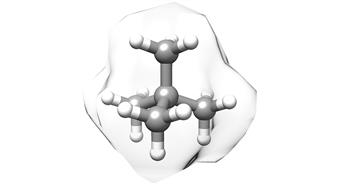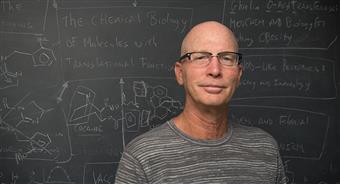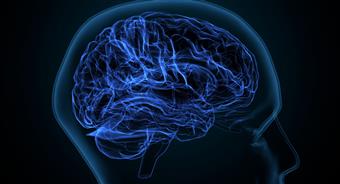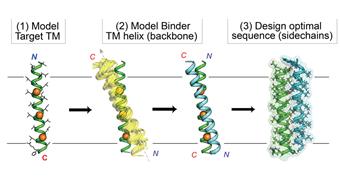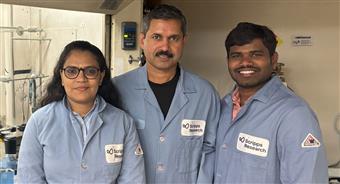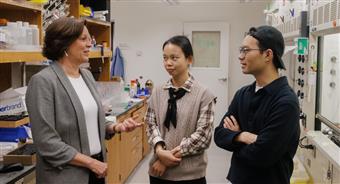
Mirror-image molecules pave new path for cancer drug discovery By comparing how mirror image versions of small molecules impact clusters of proteins, Scripps Research scientists can identify potential new drug targets.
April 27, 2023
LA JOLLA, CA Scripps Research scientists have developed a new strategy for identifying small molecules that can change the function of proteins, offering a promising path for discovering targeted drugs. In collaboration with scientists at other institutions, the group used their new approach to find small molecules that can alter the activity of proteins involved in cancer.
The research, published in Molecular Cell on April 20, improves on previous methods that could screen for whether small molecules selectively attached to proteins, but not whether they affected the proteins' biological activities. The new method revolves around using two mirror-image versions of a small molecule and comparing how they change the size of protein complexes in cells.
The ability of small molecules to specifically bind to a protein and cause a biological consequence is the fundamental basis for most drugs today, says senior author Benjamin Cravatt, PhD, Gilula Chair of Chemical Biology at Scripps Research. With this assay, we're expanding our ability to discover these small molecules that not only bind proteins, but have functional impacts.
In recent years, Cravatt's lab has designed sets of small chemicals that can irreversibly bind to certain parts of proteins. However, screening these chemical libraries to discover their possible impact on protein function was generally a slow and tedious process. Since individual proteins have different roles in cell biology, researchers often have to develop specialized functional screens for each protein of interest. One screen, for instance, might determine whether the chemicals affected cell growth, while another might determine whether the chemicals changed levels of a different molecule.
Just because a small molecule engages a protein physically doesn't mean that it changes the protein's function in the cell, says co-first author Jarrett Remsberg, PhD, who carried out the work as an American Cancer Society postdoctoral research fellow in the Cravatt lab at Scripps Research. Former graduate student Michael Lazear, PhD and postdoctoral fellow Martin Jaeger, PhD were also first authors of the paper.
In the new work, Cravatt's group used the conglomeration of proteins into complexes as a proxy for their function. Proteins often work by binding to other proteins if this binding doesn't happen or if it is induced to happen, it indicates a protein's function may have changed.
The research team designed pairs of mirror image molecules, called stereoisomers, that could each bind irreversibly to proteins in the same way that their previous chemical libraries had worked. The pairs of stereoisomers let them be sure that the impact of each small molecule was due to its unique structure (if only one version of a molecule changes the proteins' function, it is likely a specific and direct interaction). Once they exposed cells to the pairs of stereoisomers, they tested whether a protein-of-interest was in a different size complex, using a technique called size exclusion chromatography in which proteins are sifted through beads with different sized pores.
To show the utility of this approach, the researchers screened the set of small molecules for their ability to change the sizes of protein complexes in prostate cancer cells. They pinpointed a molecule, MY-1B, which selectively disrupted a complex of proteins known as PA28, previously found to play a role in degrading proteins in cancer. Further work in leukemia cells confirmed that, by specifically binding to the protein PMSE1, MY-1B or a related compound (but not their mirror images) could effectively inactivate the PA28 complex.
Cravatt and colleagues also followed up on an observation that a different chemical, EV-96, changed the size of a protein complex involved in splicing strands of RNA inside cells. The team discovered that EV-96 slowed the growth of cancer cells and pinpointed SF3B1 as the protein the chemical was binding to.
In both cases, the new chemicals represent the first time scientists have been able to target the protein complexes PA28 and the so-called spliceosome with small, simple synthetic chemicals.
This means that researchers have new chemical tools in their arsenal that they didn't have before, says Remsberg. It's an opportunity for better understanding these proteins as well as investigating potential therapeutic opportunities.
The team hopes their approach can be expanded to use other functional readouts than complex size, and they intend to use it to study different cell types in the future.
The long-term idea is that we can use this approach to discover chemical compounds that impinge upon any readout, says Cravatt. There are certainly other readouts that we hope to be able to look at in the future.
In addition to Cravatt, Remsberg, Lazear and Jaeger, authors of the study, Proteomic discovery of chemical probes that perturb protein complexes in human cells are Kristen E. DeMeester, Evert Njomen, Sang Joon Won, Michael A. Schafroth, Daisuke Ogasawara, Minoru Yokoyama, Garrett L. Lindsey, Haoxin Li, Jason Germain, Sabrina Barbas, Thomas W. Hanigan, Vincent F. Vartabedian, Christopher J. Reinhardt, Melissa M. Dix, John R. Teijaro and Bruno Melillo of Scripps; Katherine Rothamel, Hsuan-lin Her and Gene W. Yeo of UC San Diego; Simon J. Hogg, Jahan Rahman and Omar Abdel-Wahab of Memorial Sloan Kettering Cancer Center; Landon R. Whitby and Gabriel M. Simon of Vividion Therapeutics; Joan Vaughan and Alan Saghatelian of The Salk Institute; Seong Joo Koo, Inha Heo, Brahma Ghosh, and Kay Ahn of Jansse
More from Scripps
20/04/2024
New copper-catalyzed C-H activation strategy from Scripps Research Two-mode reactions inspired by human detox enzymes offer powerful new tools for drug discover...
12/04/2024
Scripps Research chemists devise easier new method for making a common type of building block for drugs Scientists transform simple linear amines into saturated...
06/04/2024
A simple, inexpensive way to make carbon atoms bind together A Scripps Research team uncovers a cost-effective method for producing quaternary carbon molecules,...
04/04/2024
Developing a vaccine for the zombie drug xylazine Scripps Research chemical biologists design an early proof-of-concept vaccine that could lead to the first...
30/03/2024
How blocking a neural receptor responsible for addiction could reduce alcohol use A Scripps Research team found that a new therapeutic that targets the kappa op...
13/03/2024
New computational strategy boosts the ability of drug designers to target proteins inside the membrane Customized-design approach could streamline the design of...
29/02/2024
Scripps Research scientists reveal how first cells could have formed on Earth New phospholipid discovery brings researchers closer to understanding how primordi...
29/02/2024
How molecular handedness emerged in early biology Scripps Research chemists fill a major gap in origin-of-life theories.
February 28, 2024
LA JOLLA, CA Mole...
22/02/2024
Snaking toward a universal antivenom Scripps Research scientists discovered antibodies that protect against a host of lethal snake venoms.
February 21, 2024
...
06/02/2024
Calibr-Skaggs announces expansion of option and license agreement with AbbVie to develop novel cell therapies for solid tumors and autoimmune diseases
AbbVie...
26/01/2024
Re-energizing mitochondria to treat Alzheimer's disease Scripps Research team restored neuron-to-neuron connections in human cells.
January 25, 2024
LA JO...
24/01/2024
100 years of Science Changing Life: Scripps Research celebrates a century of transforming human health For the last century, institute leaders and renowned scie...
23/01/2024
New technology lets researchers track brain cells' off switches The method could shed light on what goes awry in numerous brain conditions when neurons ar...
09/01/2024
Three decades of giving: Announcing the Calibr-Skaggs Institute for Innovative Medicines The ALSAM Foundation, founded by the Skaggs family, provides lasting g...
04/01/2024
Life science entrepreneur Gene Lay joins Scripps Research Board of Directors Lay, founder of the global biotech company BioLegend, brings invaluable experience ...
21/12/2023
Taming a plant-derived toxin Scripps Research team modifies the traditional poison picrotoxinin for potential neurological drugs and anti-parasite treatments. ...
19/12/2023
Scripps Research Executive Vice President Eric Topol gives TED talk on transformative power of AI in medicine Topol provides an overview of how AI models can i...
13/12/2023
New AI-powered algorithm could better assess people's risk of common heart condition Early detection of atrial fibrillation can reduce the risk of stroke an...
07/12/2023
Nanoparticle flu vaccine design shows promise in early tests Scripps Research-designed vaccine could provide broad, enduring protection against influenza A str...
16/11/2023
Numerous Scripps Research scientists named Highly Cited Researchers Clarivate's annual, global list represents researchers who have demonstrated significant...
07/11/2023
Multiple sclerosis drug invented at Scripps Research slows long-term devastating disease progression Late-breaking data reinforces the effectiveness and safety ...
05/10/2023
Keren Lasker named a 2023 Moore Inventor Fellow The prestigious award will support Lasker's inventive research in membraneless organelles and their applica...
22/09/2023
Michael Bollong named a 2023 Amgen Young Investigator The prestigious award will support Bollong's research identifying new molecular targets and therapeuti...
09/09/2023
Philip Dawson receives 2024 American Chemical Society National Award Dawson is honored with the Arthur C. Cope Late Careers Scholar Award for his foundational c...
07/09/2023
Scripps Research chemists devise a method for C-H activation of alcohols The method represents a new toolkit for making drugs and other compounds.
September 06...
31/08/2023
Scripps Research receives $1.5M to surveil infectious disease threats in wastewater Bill & Melinda Gates Foundation award to support the development of multi-pa...
16/08/2023
How cold temperatures trigger the brain to boost appetite Scripps Research scientists' discovery could lead to new weight loss and metabolic health treatmen...
08/08/2023
Human antibody that targets carfentanil, fentanyl and related opioids reverses overdose effects in preclinical study Scripps Research-developed antibody therapy...
04/08/2023
How sensory neurons impact the gut Scripps Research scientists show that the receptor PIEZO2 in sensory neurons controls gut motility and transit time, which a...
26/07/2023
AbbVie and Calibr Expand Strategic Collaboration to Advance Several Preclinical and Early-stage Clinical Assets The expanded strategic collaboration will advan...
23/07/2023
Scripps Research scientists develop AI-based tracking and early-warning system for viral pandemics Machine-learning system effectively predicts emergence of pro...
19/07/2023
Monitoring T cells may allow prevention of type 1 diabetes Scripps Research study shows that analyzing T cells in blood samples could be used to select at-risk ...
19/07/2023
Scripps Research mourns passing of leading organic chemist Albert Eschenmoser Eschenmoser pioneered key reactions in synthetic chemistry and shaped the understa...
15/06/2023
Scripps Research awarded $46.8 million by NIH to promote human health through innovative translational science and training The Translational Institute is harne...
13/06/2023
Scripps Research's Danielle Grotjahn named 2023 Pew Scholar in the Biomedical Sciences The award will support Grotjahn's study of how cells assemble the...
31/05/2023
Crossing the ring: new method enables C-H activation across saturated carbocycles Scripps Research chemists add another powerful tool to their molecular editin...
24/05/2023
Scripps Research develops behind-the-scenes tool for better biomedical data discovery The new resource makes datasets more discoverable for life science communi...
19/05/2023
Scripps Research neuroscientist Hollis Cline elected to American Academy of Arts and Sciences Cline is recognized for her discoveries about the role of sensory ...
19/05/2023
Scripps Research's Skaggs Graduate School awards doctoral degrees to 31st graduating class Commencement ceremony will be livestreamed via Zoom and on instit...
13/05/2023
A better route to benzocyclobutenes, sought-after building blocks for drugs Scripps Research chemists devise a new, C-H activation-based method for the synthesi...
09/05/2023
Renowned Scripps Research professor Jeffery Kelly elected to National Academy of Sciences Kelly's groundbreaking work on protein misfolding has led to thera...
28/04/2023
Mirror-image molecules pave new path for cancer drug discovery By comparing how mirror image versions of small molecules impact clusters of proteins, Scripps R...
22/04/2023
How alcohol consumption contributes to chronic pain A Scripps Research team showed how both alcohol intake and alcohol withdrawal can lead to increased pain and...
21/04/2023
Xin Jin receives dual awards to study autism risk genes in neurodevelopment Major grants from the National Institutes of Health and California Institute for Reg...
20/04/2023
Trim the sugar: New HIV vaccine design improves immune response Scripps Research vaccine candidate headed for clinical trials.
April 19, 2023
LA JOLLA, CA A...
18/04/2023
Therapeutic can seek and destroy potent opioid to treat overdoses Scripps Research chemists developed a new biologic to work against the synthetic opioid carfen...
07/03/2023
How heavy alcohol consumption increases brain inflammation The findings by a Scripps Research team point toward a potential new drug target for treating alcohol...
02/03/2023
Scientists find human antibodies that can block multiple coronaviruses including SARS-CoV-2 Results from a Scripps Research and UNC team pave the way for a vacc...
28/02/2023
$10 million grant funds Scripps Research Alcohol Research Center through its 50th year The five-year grant supports research into the neurobiology of alcohol us...
28/02/2023
Immune system drug shows promise in treating alcohol use disorder, a Scripps Research clinical trial reports Scientists at Scripps Research found that apremilas...
 Mirror-image molecules pave new path for cancer drug discovery By comparing how mirror image versions of small molecules impact clusters of proteins, Scripps Research scientists can identify potential new drug targets.
Mirror-image molecules pave new path for cancer drug discovery By comparing how mirror image versions of small molecules impact clusters of proteins, Scripps Research scientists can identify potential new drug targets. 















